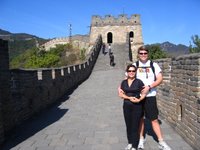Xi'an and the Terracotta Warriors.



Our books say Xi'an is a city which melds perfectly the ancient with the modern. Heather and I disagree whether this is accurate. I see what they mean: it is a walled city, the center of which is dominated by a giant 14th Century pagoda-shaped Bell Tower. All roads leading to the Tower are dominated by neon and cutting edge digital imagery. Thus, standing at any corner, you take in 600-odd years of Chinese culture and architecture. (Heather's position: The architectural blending of the old against the new is poorly executed. One example is the top of the castle type city wall outlined by strings of small, tacky lights. It's almost Vegas-like. What they should have done: up-lighting of the wall to capture its immense presence and grandeur).
We signed up for a day long tour to include the Museum of the Terracotta Warriors. In 1974 a peasant farmer drilling a well stumbled upon the buried "eighth wonder of the world," a 2000-year-old army of meticulously sculpted warriors and horses commissioned by order of Qin Shi Huang, who expected the army to protect him in the afterlife. Unless you are President Clinton, you cannot climb down among the warriors, but we snapped these photos from the viewing area. A couple of the warriors looked kind of familiar.
The famous farmer who discovered the warriors was on hand to sign the museum picture book and ease our decision whether to splurge on the 120 Yuan (about $12) to buy it. We succumbed and he duly autographed it. Like other day tours, the guides packaged on other less interesting sights, including a tour of Chiang Kaishek's bathroom at the headquarters from which he was kidnapped in 1936.
















